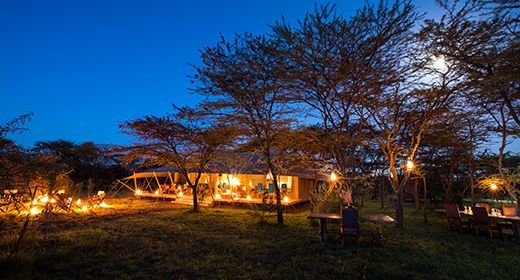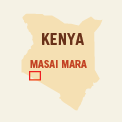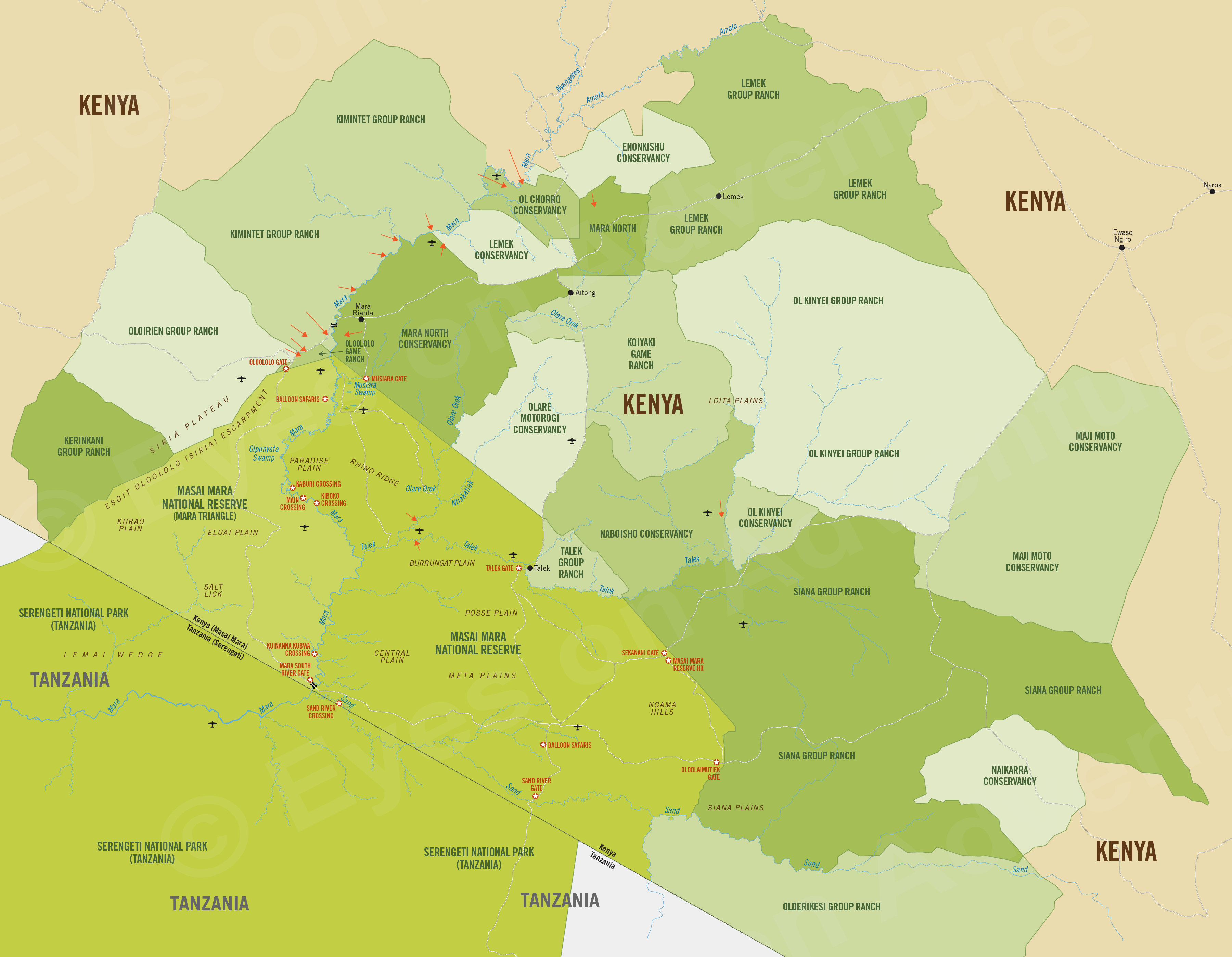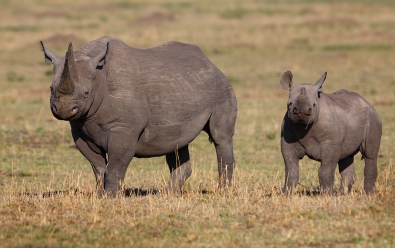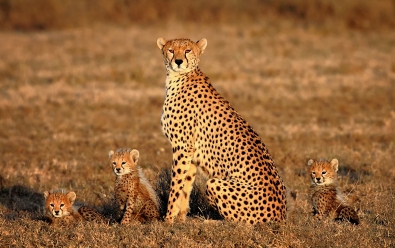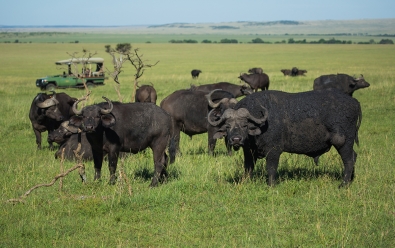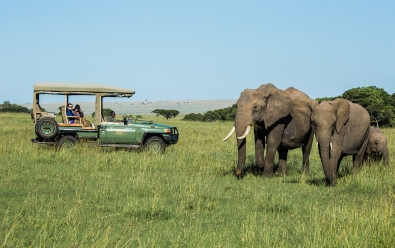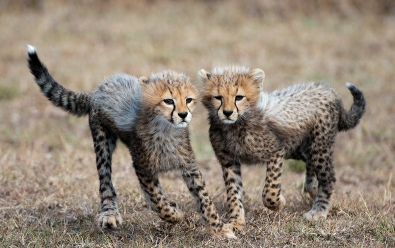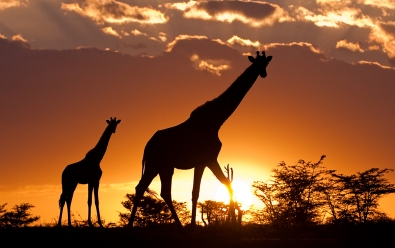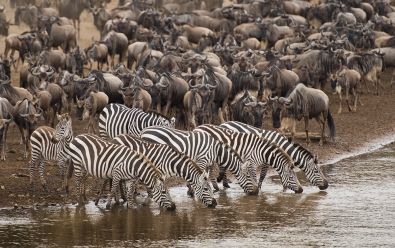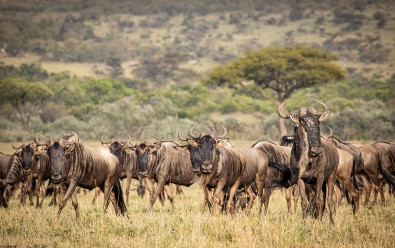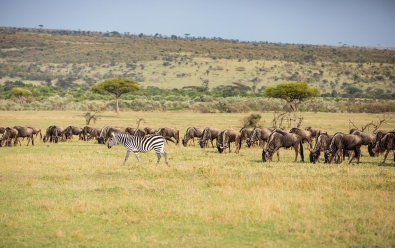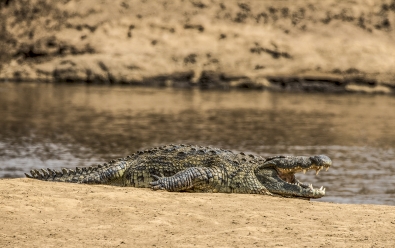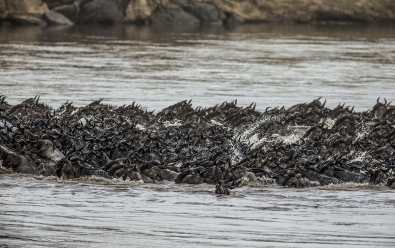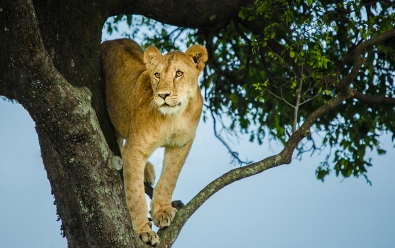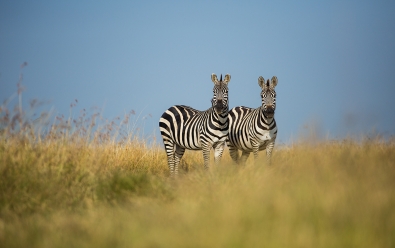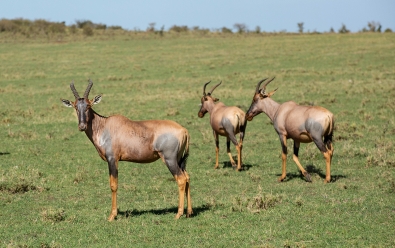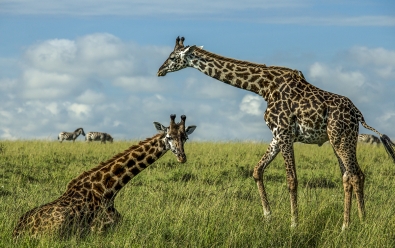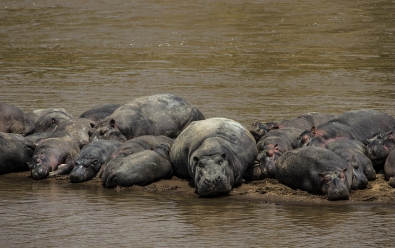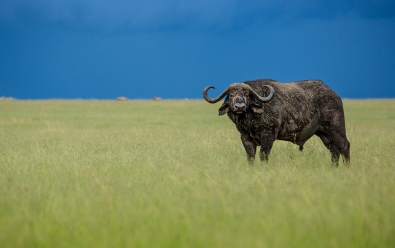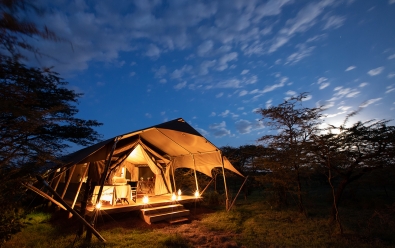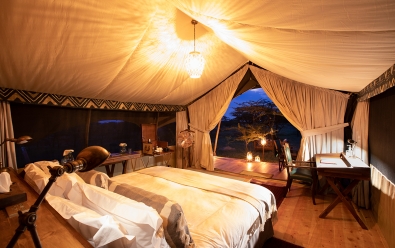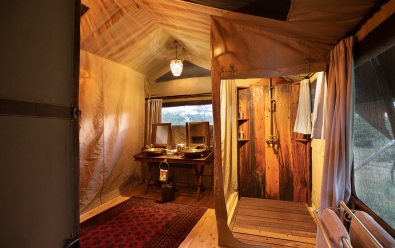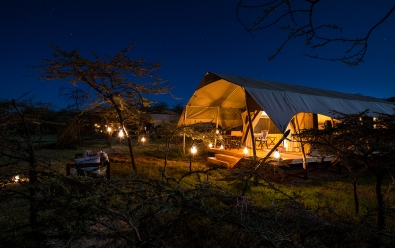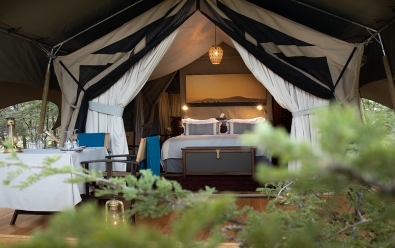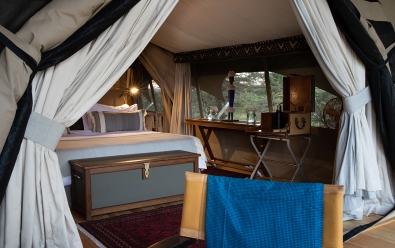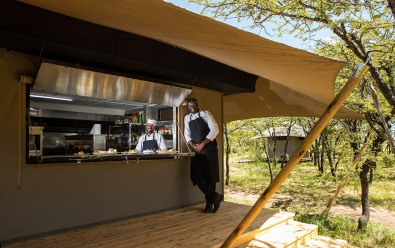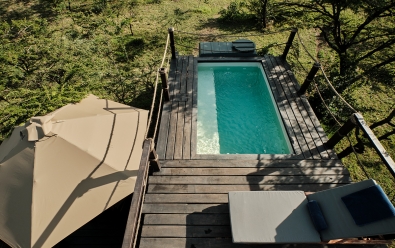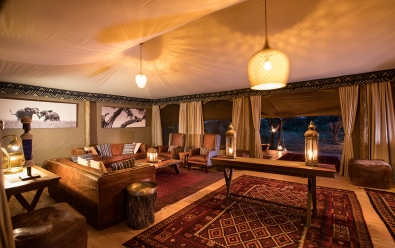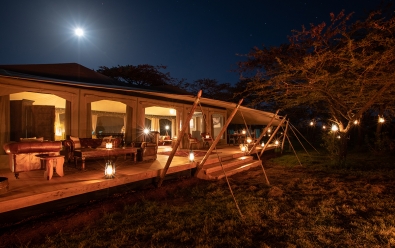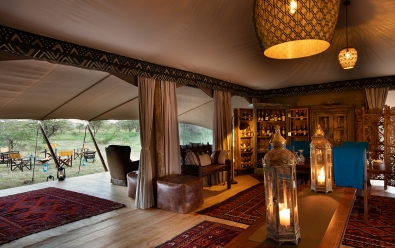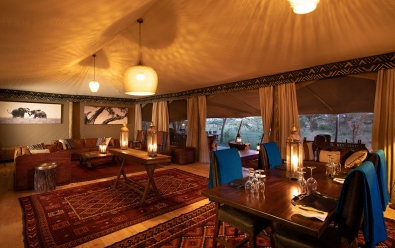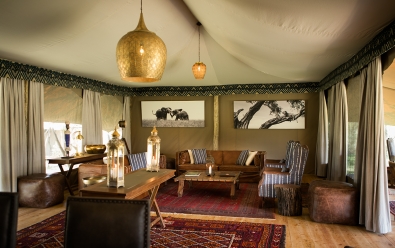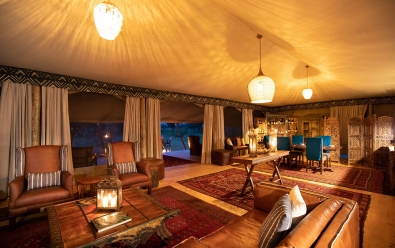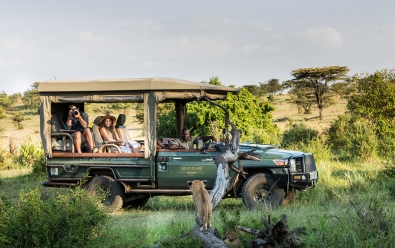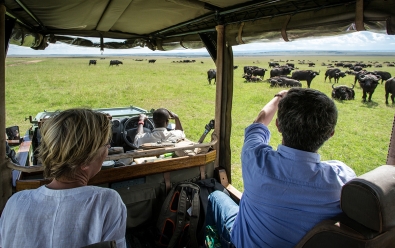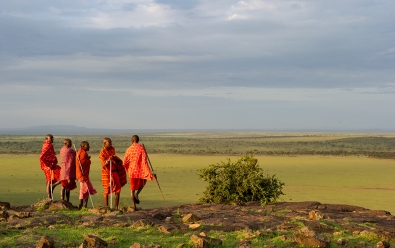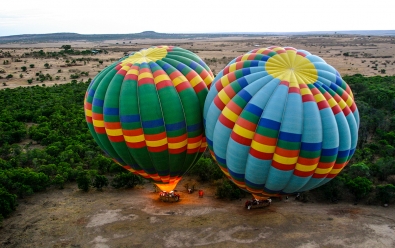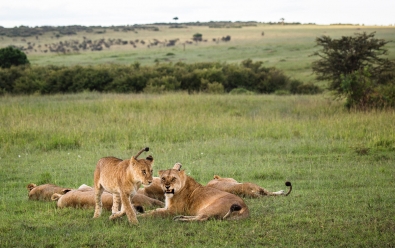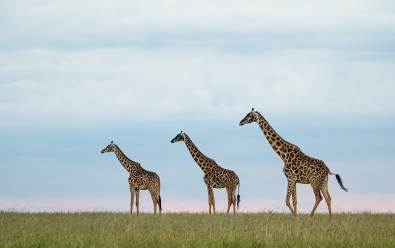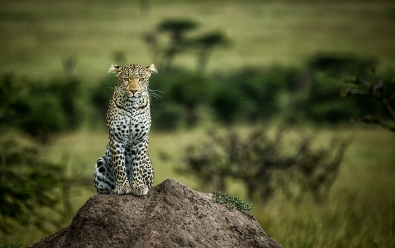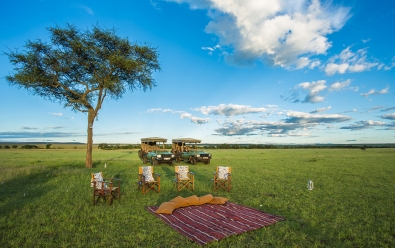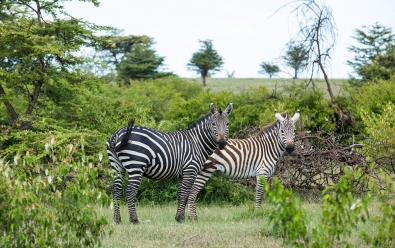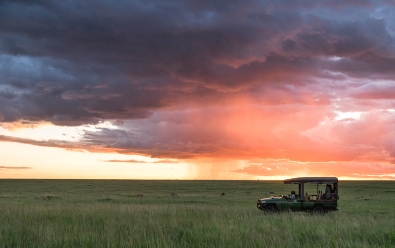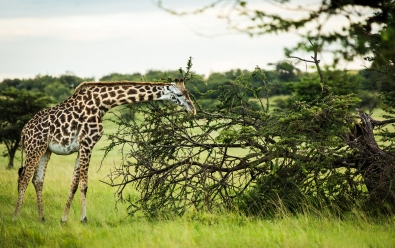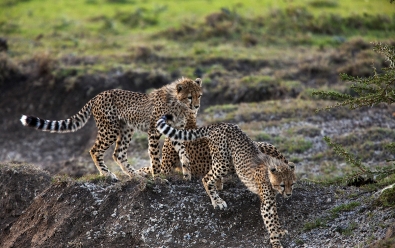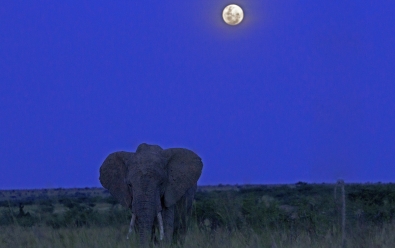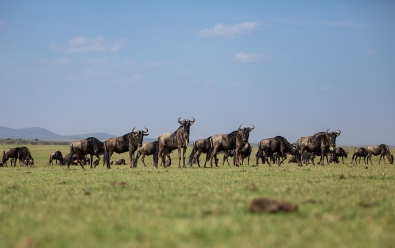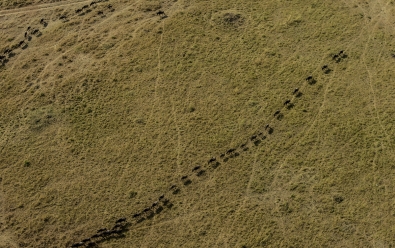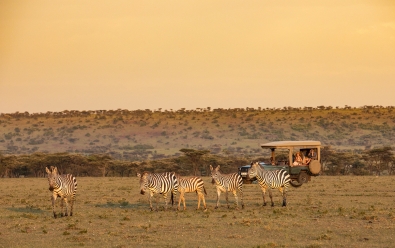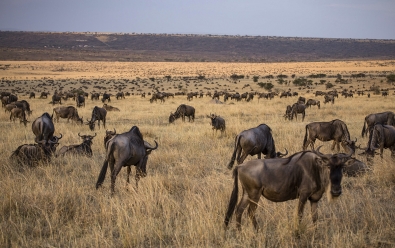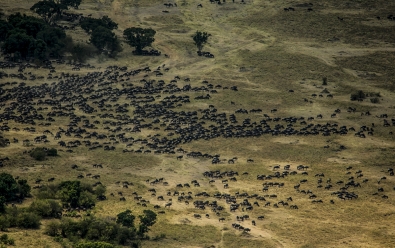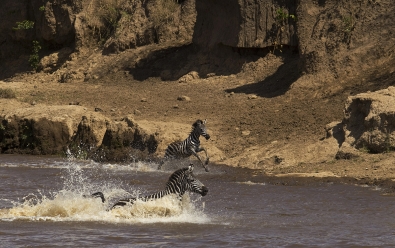Mara Expedition Camp
Highlights
- Excellent wildlife viewing throughout the year.
- Modeled after a mobile safari camp of early explorers.
- The area is visited by the Great Migration.
- Game drives, walking, cultural experience.
Location
- Masai Mara Reserve
- Greater Masai Mara
- Southwest Kenya
Mara Expedition is located on the northern edge of the Masai Mara National Reserve and offers a romantic tented experience very similar in style to the safaris of East Africa's early explorers, but with modern conveniences and luxuries.
The camp is located in an uncrowded section of the national reserve and guests staying at the camp have access to the entire reserve, as well as the private Mara North Conservancy, which means game drives can avoid crowded wildlife sightings that can occur in the more camp-dense areas to the west, closer to the Mara River.
During the peak Great Migration months (generally mid-July thru October, read more below), guests staying at Mara Expedition Camp may want to spend time their days closer to the rivers to have a chance at witnessing g a dramatic iver crossings or just to explore a bit more, so full-day safaris are offered.
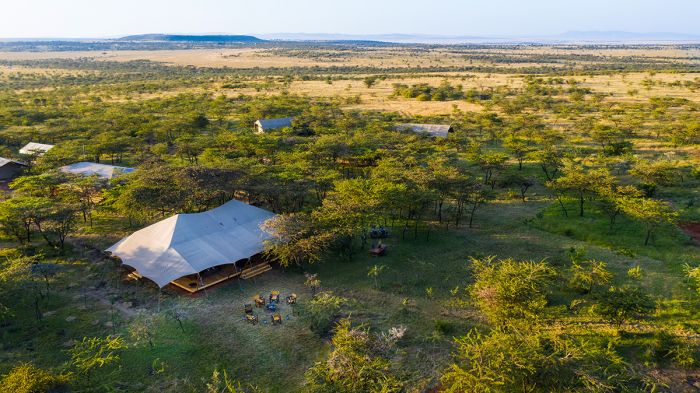
Aerial view of Mara Expedition Camp.
Mara Expedition Camp is owned and operated by Great Plains Conservation, an organization whose mission is to blend sustainable tourism with the conservation of wildlife environments. Great Plains is headed by the husband-and-wife team of Beverly and Dereck Joubert, who are well known to wildlife enthusiasts for their outstanding films, most of which have been created in conjunction with National Geographic.
Great Plains use the term “Conservation Tourism” to describe what they do. They define it as the use of quality-led tourism experiences that are environmentally sound, with the benefits going specifically into making the conservation of an area viable and sustainable.
The Great Plains model takes stressed and threatened environments, surrounds them with compassionate protection and intelligent, sustainable management, and funds them with sensitive, low-volume, low-impact tourism.
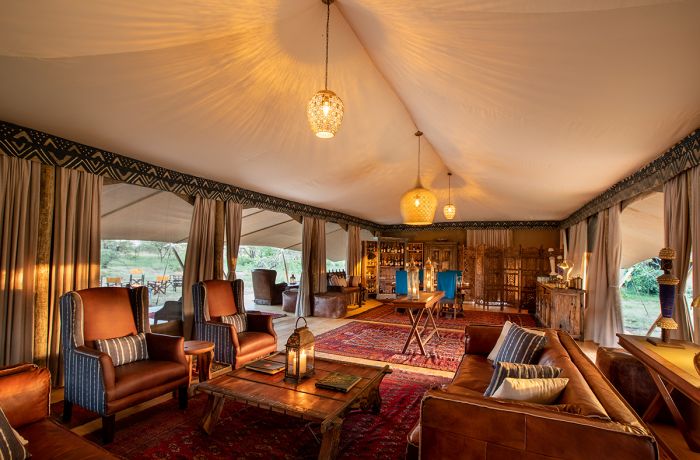
Main area lounge and dining tent at Mara Expedition Camp.
Activities at Mara Expedition Camp focus on game drives in custom-designed, open 4x4 vehicles to see the diverse wildlife. Those looking for additional adventures can pre-book an early morning, hot-air balloon flight above the Masai Mara and get an incredible, bird's-eye view of this spectacular setting from above (highly recommended). Cultural experiences with the local Maasai people are also offered.
Mara Expedition Camp offers six classic, Meru-style safari tents, one of which is a two-bedroom tent suitable for three adults traveling together or a family with children. The tents evoke the romantic and adventurous time of the early European explorers, with campaign-style furniture, Persian rugs, and brass and copper fixtures. The tents include plumbed, en-suite facilities with a hot-and-cold water shower, wash basins, and flush toilet.
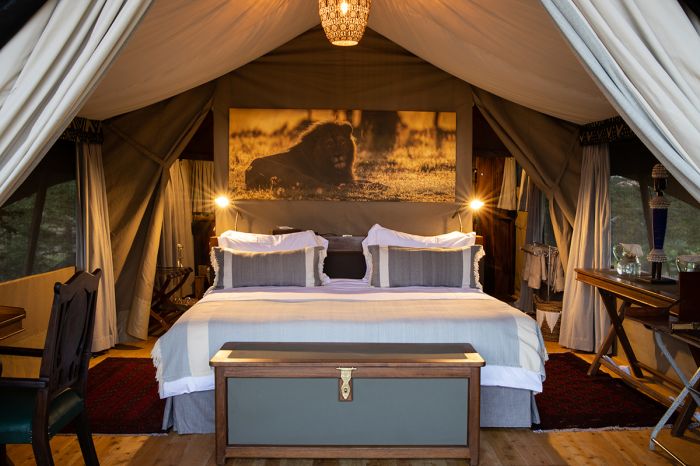
Guest tent bedroom at Mara Expedition Camp.
The main camp area is constructed amongst a grove of Acacia trees and is designed to emulate the mobile safari camps of Africa's early explorers. The Bedouin-style, open-air tent (with roll-down flaps and curtains) comprises the camp's public area and contains the guest lounge and dining space. The grounds outside the tent are also often used for al-fresco dining.
The authentic classic-safari look and feel of the camp creates a nostalgic atmosphere of elegance, mixed with adventure and relaxation. A unique plunge pool and elevated sundeck offers a cool respite for the midday hours.
Great Plains are one of Africa's leading safari operators and they strive to minimize energy consumption at all their camps. The camp was constructed using only repurposed hardwoods and all of the camp’s electricity comes from its solar-power system.
Mara Plains Camp is at the top in terms of its environmental credentials and careful appointments. Strict eco-friendly environmental standards are maintained so that no harmful chemicals or waste is allowed to enter the pristine ecosystem of the Masai Mara.
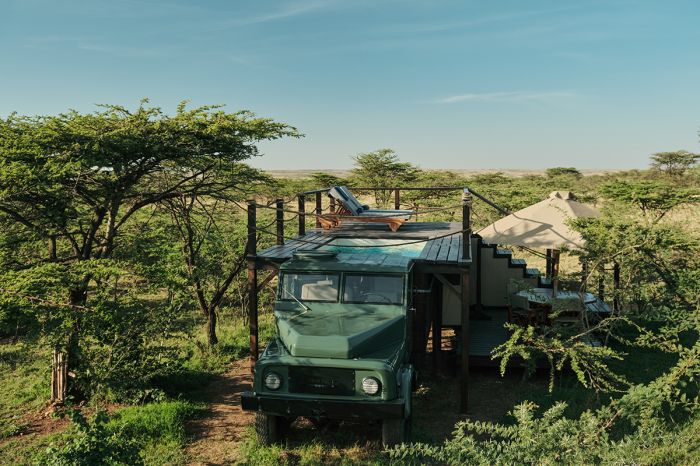
The unique plunge pool at Mara Expedition Camp.
About the Masai Mara
The Greater Masai Mara includes the Masai Mara National Reserve as well as numerous private conservancies that border the reserve. The national reserve and bordering conservancies are often collectively referred to simply as "the Mara".
The Greater Masai Mara is part of a much larger ecosystem that includes vast protected areas directly to the south in Tanzania, including Serengeti National Park, the Ngorongoro Conservation Area, and other reserves that together make up the Greater Serengeti.
The combined Greater Serengeti-Mara ecosystem, which combines the areas described above, covers roughly 15 000 square miles (39 000 sq kms).
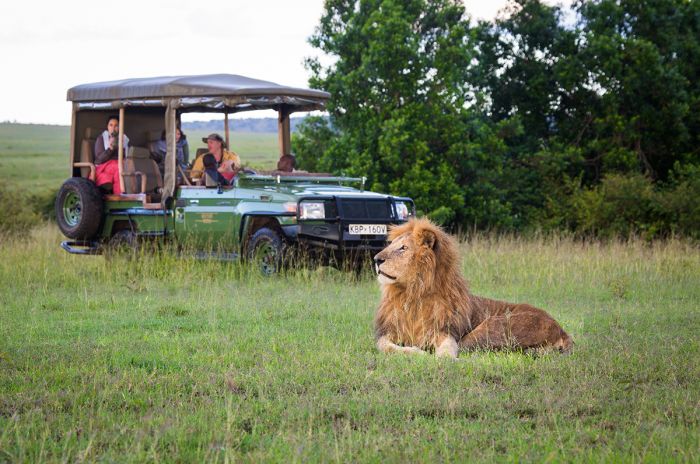
Lion sighting on a game drive in the Masai Mara.
The Serengeti-Mara is home to a very large number and diversity of wild animals and is also the location of the well-known "Great Migration" of over 2 million herbivores (read more below). This is arguably Africa's greatest overall wildlife destination.
Wildlife densities in the Greater Masai Mara are some of the highest in Africa, with commonly seen herbivores including blue wildebeest, plains zebra, Thomson's gazelle, topi, Grant's gazelle, hartebeest, giraffe, elephant, buffalo, impala, waterbuck, bush bug, warthog, and many others.
Predators seen often include lion, leopard, spotted hyena, cheetah, serval, and jackal. Hippo and crocodile are found in large numbers in the Mara River.
Masai Mara National Reserve
The national reserve forms the core protected area of the Greater Masai Mara, covering 583 square miles (1 510 sq kms) and officially protected since 1974. The reserve is functionally the same as a national park, with restrictions on off-road driving and open to the public, which includes self-drivers coming for the day, as well as guests staying at one of the accommodations within the reserve (of which there are many).
The Mara Triangle
The Mara River flows southward through the national reserve on its way into Tanzania and eventually into Lake Victoria to the southwest. The river also separates the national reserve into two separately-managed sections: the area to the west of the Mara River is known as the "Mara Triangle", while the area to the east of the river is simply the Mara National Reserve.
The Mara Triangle covers 197 square miles (510 sq kms), which is roughly one-third of the reserve and there are relatively few safari camps in this section, so the number of vehicles and tourists, especially during the peak months when the migration is in present, is much lower in the Triangle section than in the section east of the Mara River.
The Great Migration
One of nature's greatest living spectacles is the Great Migration, a term given to describe the year-long, circular, clockwise march of over two million herbivores across the Masai Mara and Serengeti grasslands. The migration animals are made up entirely of two species: the blue wildebeest and the plains zebra (the majority of which are wildebeests).
The migrating herds follow their instincts to seek out fresh grazing and so the migration is ongoing, with the herds ever moving and taking a full year to complete a cycle across the Masai Mara and Serengeti. The animals move not as one herd, but as tens of thousands of animals in multiple herds of various sizes and spread out for many miles as they move.
The wildebeests and zebras take advantage of strongly seasonal conditions, spending the wet season (November through May) on the plains of Tanzania's Serengeti and the dry season in Kenya's Masai Mara. The wildebeests give birth between January and March on the short grass plains in Tanzania.
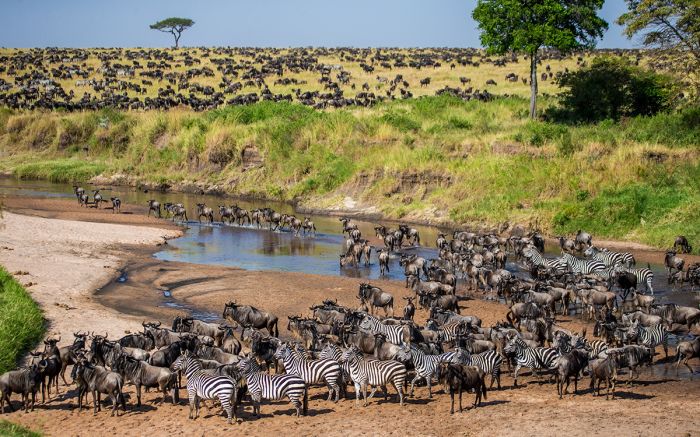
The Great Migration along the Sand River in the Masai Mara.
The timing of the migration is rarely ever the same year-to-year, as local conditions influence grass growth and as such, the location of the bulk of there animals cannot be known precisely. Rains and other unknown conditions seem to direct the timing of the migration, but generally, it is known within several weeks when the animals will be in a general location.
The migration typically crosses north into Kenya and the Masai Mara beginning sometime in mid- or late-July and they spend around three months in the Greater Masai Mara. The herds head back south into Tanzania sometime in October.
Although many visitors time their visit to the Masai Mara to coincide with the Migration, the Greater Mara has superb wildlife viewing outside of the migration period. This is because it is only the wildebeests and zebras that migrate, the rest of the animals, including the major predators like lion, leopard, spotted hyena, and cheetah, as well as all the other herbivores, including springbok, gazelles, elephant, topi, hartebeest, and many others, do not migrate.
A popular aspect of experiencing the Great Migration is observing a herd as it crosses the Mara River, which requires animals swimming through waters inhabited by large Nile crocodiles that wait for a chance to get their first substantial meal in many months.
The dramatic river crossings (which take place along the Mara River in both Kenya and Tanzania) are certainly a spectacle and not for the faint of heart, with many of the wildebeest and zebras taken by crocs or succumbing to drowning or trampling in the chaos.
The best chances for seeing a Kenya Mara River crossing are during July and August, when the crocodiles are still very hungry.
Mara Conservancies
Over the past two decades, nearly all of the land situated surrounding the Masai Mara National Reserve has been organized into protected and self-managed reserves by various tribes of the Maasai people that own the land. The result has been a great expansion of wildlife tourism and the construction of safari tourism camps and lodges.
Note that some of the conservancies use the name 'group ranch' instead of conservancy.
Many of these conservancies, particularly those that directly border the national reserve, offer wildlife viewing that is even just as good, and arguably even better than inside the reserve, primarily because the conservancies are only available to tourists staying at a camp within the conservancy and unlike the national reserve itself, are not accessible to self-drive day visitors.
The exclusivity of the conservancies means that there are fewer game drive vehicles and a far lower density of tourists. Further, the number of vehicles allowed at any specific animal sighting (such as a lion kill or a leopard in a tree) is managed to prevent the oft-seen situation where an animal, such as a cheetah, is surrounded by 20 or more cars in the national reserve.
Staying in one of the Mara Conservancies offers guests the opportunity to have an exclusive game-viewing experience (due to the reduced tourist numbers compared to inside the national reserve), while still allowing day visits into the reserve proper (entrance fee required). A day visit into the reserve might allow seeing a major wildebeest/zebra river crossing during the migration months. Guided safari walks (during the day) and game drives past sunset are another option inside the conservancies that is not permitted inside the national reserve.
ROOMS INCLUDES & EXCLUDES CHILDREN FACILITIES ACTIVITIES
Accommodation
6 guest accommodations in total comprising:
- 5 Meru-style, canvas safari tents. Double or twin-bedded setup are both available.
- 1 two-bedroom, Meru-style, canvas safari tent designed for a family or two couples traveling together. Double or twin-bedded setup are available for each bedroom. Each bedroom has its own separate fully-plumbed bathroom that includes a campaign-style, hot-and-cold-water shower, double brass-wash-basins, and a flush toilet. This unit can accommodate a maximum of 2 adults and 2 children or 3 adults sharing.
Each safari tent includes campaign-style furniture, Persian rugs, and brass and copper fixtures. The fully-plumbed bathrooms include a campaign-style, hot-and-cold-water shower, double brass-wash-basins, and flush toilet.
The guest tents are connected to the main camp area by earthen footpaths on the ground.
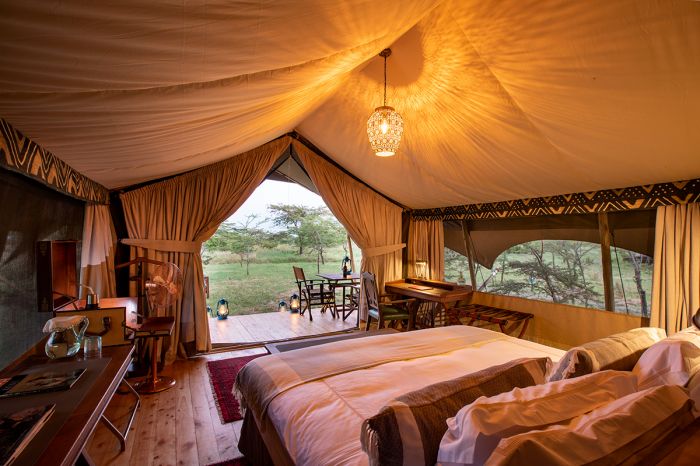
Guest tent interior at Mara Expedition Camp.
The style of the camp and its guest tents evokes adventure and nostalgia, brining one back to stories about the early days of colonial exploration in East Africa.
The tents include specially-crafted furnishings that replicate those used by the early explorers from a bygone era, creating a romantic experience. The interior décor is sourced from Zanzibar and the Far East, with colorful rugs and recycled hardwoods.
The tents are at ground level on slightly-raised, wooden platforms. In front of each tent is a covered veranda with seating.
Other items and features in all of the guest units include:
- Writing desk and chair.
- No mosquito netting over the beds, but the tents are completely enclosed with canvas and mesh.
- Tea-and-coffee station.
- Electronic safe.
- Standing fan.
- Yoga mats.
- Wi-Fi in the guest tents and main camp area.
- The tents have individual solar panels for 24-hour electricity.
- The solar-power system does not allow for hairdryers, shavers or any high-wattage device.
- The cellular connection is reasonably reliable. No cell phones or computers are allowed in the public areas of the camp nor on game drives; only in the guest rooms.
- Personal amenities, including soap, shampoo, conditioner, and lotion.
Mara Expedition Camp can accommodate a maximum of 14 guests in total: 2 guests in each of the 5 standard tents and up to 4 persons in the two-bedroom tent. Triples in a standard tent are not available.
Includes & Excludes
Includes:
- All meals and alcoholic and non-alcoholic beverages, including premium brand spirits and Champagne.
- Safari experiences (twice-daily or full-day game drives and birding) accompanied by an experienced guide in both the Masai Mara National Reserve and Mara North Conservancy.
- Laundry services are provided on a daily basis (weather permitting, items will be returned on the same day). Laundry is dried by the sun and on most days any laundry placed out in the morning will be returned by the evening.
- One pair of high quality binoculars and a professional camera body and lens kit for complimentary use. Photos will be downloaded to a memory stick on guest’s departure.
- The return, scheduled, seat-in-plane air transfers from Nairobi Wilson Airport to this camp are excluded from the nightly rate. However, when combined with either Mara Plains or Mara Nyika camps, return, scheduled air transfers to/from Nairobi Wilson Airport are included (subject to a minimum 2-night stay per camp).
- Ol Kiombo airstrip transfers.
- Wi-Fi access.
- Tourism Levy & VAT.
Excludes:
- Hot-air ballooning (best to book this in advance).
- Any applicable wildlife fee, park fee, reserve fee, concession fee, other land-use fee.
Single Supplement
A single supplement may apply for any room booked by a single traveler; please ask us for pricing.
Children
Children aged 6 years and older are accommodated at Mara Expedition Camp:
- The 2-bedroom tent can accommodate a family of 2 adults and 1 or 2 children.
- Child rates are applicable for up to two children aged 15 and younger sharing with two adults in the family tent.
- Child rates are applicable for up to one child aged 15 and younger sharing with one adult in a tent, when available.
- Children 15 and younger must share a room with at least one adult.
- Children aged 16 years and older will pay applicable adult rates and be accommodated in a separate tent.
- Families will be combined with other guests on all activities.
- Activities will cater to family ability and safety. Some activities have a specific age-related restriction.
- Children can participate in walking activities from 12 years of age. Walking is only offered in the area around the camp.
- Young children must be supervised by their parents, as the camp is not fenced and is located in an area with high predator densities.
- The Great Plains Young Explorers program is thoughtfully designed to give children a range of experiences and topics from birding to cooking, to art, to wildlife tracking.
Facilities
Mara Expedition Camp is located in a remote section of the private Naboisho Conservancy amongst a grove of Acacia trees and overlooking a shallow valley.
The entire camp area is designed to mimic the mobile safari camps of Africa's early explorers. The main guest area consists of a single, Bedouin-style, open-air tent that comprises a lounge with comfortable seating and an indoor dining space.
The main area tent has hight ceilings and is open on the front and back, with mesh, roll-up flaps and full height curtains in case of insects or wind. The authentic classic-safari look and feel of the camp creates a nostalgic atmosphere of elegance, mixed with adventure and relaxation.
Main guest area facilities include:
- A single, open-air tented space that features lounge and covered dining area.
- Outdoor campfire area with seating.
- A unique, elevated plunge pool and deck that is built into the bed of a World War II truck.
- A bar with a coffee-and-tea station.
- Interactive kitchen.
- Dining is typically communal, but private dining is available on request.
- All dietary requirements are catered for, from regular to vegan to children; prior notice required.
- Complimentary Wi-Fi access.
- The cellular connection is reasonably reliable. Note that cell phones or computers are allowed in the public areas of the camp nor on game drives; only in the guest rooms.
- Mineral water is provided in the main camp areas and in the guest tents.
- The camp is run using a solar-power system that produces 240-volt, 24-hour electricity to the tents and main area. There is also a generator used as a back-up.
Activities
Mara Expedition Camp focuses primarily on game drive safaris, with some bush walking also offered in the area around the camp.
Activities included in the rate:
- Twice daily (or full-day with picnic lunch) game drives. Drives after dark are also offered. The vehicles are custom-built Land Cruisers that are designed specifically for the conditions around the camp and photography (fold-down screens, raised roofs, photographic bars, multi-plug inverters) with individual bucket seats.
- During winter months, hot water bottles (on early morning game drives only), blankets, and lined ponchos are provided.
- Guided walks led by licensed guides with firearm training.
- Cultural visit to the Naboisho Women’s Group: The group is supported by the Great Plains Foundation, enabling it to purchase raw materials in bulk, including a tailor hired to work on leather products. Available to guests staying at Great Plains Conservation camps, all profits from the sale of their wares are invested back into training the women to ensure that the group is self-sustainable. Some of the items available for purchase include beaded & leather products, coasters, bracelets, necklaces, belts, dog collars, earrings, and decorated 'dawa' sticks.
- Birding.
Optional activities at additional cost:
- Private activities are on offer (subject to vehicle availability which needs to be booked in advance).
- Scenic helicopter flights ranging in duration from 30, 45 to 60 minutes. The activity is best between 11:00 and 15:00, when animal densities are high. Must be booked in advance.
Example of a typical day:
- Early morning wake-up call. Morning wake-up and activity times vary according to the seasons, activities on offer, and wildlife sightings.
- Light breakfast before departing on the morning activity.
- Return to camp for a meal and rest period.
- Meet for afternoon tea and snacks (savory and sweet choices) before departing on the activity.
- Return to camp - freshen up or meet for drinks, followed by dinner.
- Enjoy a nightcap or discussion around the fire before retiring.
Great Good Fair Poor
- Jan
- Feb
- Mar
- Apr
- May
- Jun
- Jul
- Aug
- Sep
- Oct
- Nov
- Dec
General Tips
The best to to visit the Masai Mara is during the dry season, between June and October, which also happens to coincide with the arrival of the Great Migration into Kenya (read more about this below).
Besides the Great Migration, the other big factor that impacts a stay in the Mara is rains. The region experiences most of its rain between November and May, but there are two somewhat distinct rain seasons, the 'short' rains and the 'long' rains.
Mara Expedition Camp is open year-round.
Rain Season
Short Rains
The short rains occur for about one month sometime during November and December (the exact time varies somewhat year to year). This period is called the 'short' rains because the duration of an individual rain event is short and it is rare to have an all-day rain event. Most rain falls as an afternoon shower, while mornings are typically overcast or clear.
Long Rains
The long rains occur between March and May, with April being the wettest month of the year. During this tome, rain should be expected almost every day and the showers can last for hours at a time, although all-day rain is not typical. The roads in the Masai Mara become muddy and very difficult in places, which can hamper game drives. Cloudy skies are typical and temperatures can be chilly at times.
The period between the short and long rains (January and February) also receives rain, but many days are clear and the amount and duration of the rain events is unpredictable, with some afternoon showers and the odd long and heavy rainfall event.
Temperatures
The temperatures in the Greater Masai Mara do not have great variation throughout the year, as the region lies approximately 1 degree south of the equator. In general, daytime temperatures are comfortably warm and overnights and early mornings are chilly. Bring a fleece and rain jacket regardless of the timing of your visit.
Dry Season
The dry season (June to October) is sunny and warm most days and rarely hot. Rare rain showers can occur but are unlikely. From June thru August, the afternoon temperature averages 76-78°F (24-25°C), but some days can be warmer. Evenings and early mornings temperatures are often chilly, averaging 53-55°F (12-13°C).
September and October days are very pleasant, with temperatures averaging 80-83°F (28-30°C), with cool mornings persisting, averaging 53-56°F (11-13°C).
Rainy Season
The rain season is November through May (read more above) and the temperatures are fairly static throughout the season. Daytime temperatures average 79-83°F (26-28°C) and nighttime and early morning temperatures are chilly, but slightly warmer than the dry season, averaging 54-57°F (12-14°C).
The Great Migration
The annual movement of wildebeest and zebras across the Serengeti-Mara ecosystem is one of the greatest spectacles in the natural world. Many people visiting Kenya's Masai Mara (or the Serengeti in Tanzania) will time their visit to be able to experience the Great Migration of over two million animals (all of them blue wildebeests and plains zebras).
The migration moves across both the Greater Masai Mara (in Kenya) and the Greater Serengeti (in Tanzania) in a fairly consistent pattern and timeframe. The animals move to take advantage of fresh grasses on which to graze.
The large herds are well spread out, but follow a roughly clockwise and somewhat circular track across southern Kenya and northern Tanzania, taking a full year to complete. The migrating herds are in Kenya's Greater Masai Mara from around late July until sometime in October (note that the timing is never precise and varies somewhat year to year).
The wildebeests and zebras are taking advantage of the strongly seasonal conditions, spending the wet season on the northeastern plains of Tanzania and the dry season on the plains of southwestern Kenya. The wildebeest give birth between January and March on the short grass plains of the southern Serengeti in Tanzania.
The migration is rarely ever the same in terms of precise timing and direction, as local conditions influence grass growth. The wildebeest may, therefore, move off the open plains earlier in some years and remain in the northern woodlands for longer in others.




